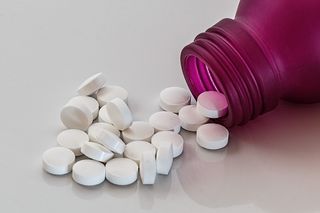Health
Is It True That "Movement Is Medicine"?
What research is telling us about the power of exercise to promote health.
Posted March 30, 2017 Reviewed by Jessica Schrader
“Movement is medicine.”
This motto summarizes in three words a theme in numerous research studies. Movement—everything from fidgeting to low-impact aerobics to interval training—can prevent some diseases, ease the symptoms of others, and even reverse some chronic conditions.
“Movement is Medicine": The Evidence

Here are just a few "headlines" from hundreds of recent studies that spotlight the role of movement in curing or easing the symptoms of various diseases and conditions. (While most studies do not prove that movement causes these positive changes, all show that exercising and activity are highly correlated with them.)
1. Physical activity can improve arthritis symptoms by 40 percent. Details here.
2. Exercise alleviates some symptoms of Parkinson’s disease and can slow its progression. As summarized here by health writer Jane Brody, regular exercise, tailored to the needs of Parkinson’s patients, “can result in better posture; less stiffness; improved flexibility of muscles and joints; faster and safer walking ability; less difficulty performing the tasks of daily living; and an overall higher quality of life.”
3. Exercise can reduce your risk of developing type 2 diabetes. Specifically, following the public health recommendation to exercise moderately for 150 minutes a week can cut your risk of developing type 2 diabetes by 26 percent, according to this study, which summarized data from over a million people. Any amount of exercise, however, was helpful in reducing risk.

4. Sitting too much for too long increases the risk of dying early. Why? Sitting for prolonged periods reduces blood flow to the legs and increases the risk of heart disease by accelerating the build-up of plaque in the arteries. Constant sitting also puts people at higher risk for diabetes, depression, and obesity. Details here.
But all is not lost. As reported in the Harvard Health Blog, as little as 25 minutes of moderate activity a day can offset some of the negative effects of eight hours of sitting. Moreover, 60-75 minutes of activity per day eliminates the risk of death entirely, even in those who sit for more than eight hours or more.
5. Older women who sit too much and exercise too little show biological aging at the cellular level. Cells of sedentary women have shorter telomeres, tiny caps at the end of DNA strands that protect chromosomes from deterioration and premature aging. See this article for specifics.
6. Standing up and walking around for five minutes every hour improves health and well-being. A study of desk workers concluded: “Standing up and walking around for five minutes every hour during the workday could lift your mood, combat lethargy without reducing focus and attention, and even dull hunger pangs, according to an instructive new study.”
7. Both aerobic exercise and weight training appear to cause striking improvements in brain health and thinking skills; it also can slow age-related decline in memory.
Numerous studies support the link between exercise and brain health. In this experiment, a small group of seniors with mild cognitive impairment improved memory and thinking skills in just six months with a weight training program. Exercise seems to have a protective effect against dementia as well. For example, in this study, exercise participants had higher brain volume, especially in the hippocampus, the memory center of the brain, thereby lowering their risk of dementia.
8. Twenty minutes of exercise can act as an anti-inflammatory. Even a short, 20-minute walk can produce anti-inflammatory effects by stimulating the immune system, according to this study.
9. Exercise can boost your mental health. Exercise can counter depression, stress, and anxiety, according to the research here. The Anxiety and Depression Association of America reports research evidence that regular exercise can work as well as medication for some people who suffer from anxiety and depression. (Note: Do not stop taking medication without consulting with your doctor.)
10. Physical activity was associated with a lower risk of 13 types of cancer. This conclusion was from a large-scale study that analyzed data from over a million people.
Various other benefits of exercise and physical activity have been well documented over the years. Exercise may strengthen bones and preserve muscle mass, thereby lowering your risk for falls and fractures. Exercise can help you lose weight or maintain a healthy weight, indirectly reducing your risk of type 2 diabetes. Exercise can prevent or ameliorate back pain, as I well know from personal experience. Moderate exercise can rev up the immune system, helping us fight off colds. Studies suggest that exercise lifts mood, raises feelings of satisfaction and self-esteem, and even makes you happier.
Most of the above benefits do not demand Herculean exercise efforts. In most cases, even small increments of activity were shown to have a positive effect. Small steps toward a more active life transform into big health gains over time.
Mini-Goals
You don’t need to become an obsessive exerciser to use movement as your medicine. Try these mini-goals:
1. Find a motivator. Is it long life, more energy, less pain, or something else? Feel free to adopt “Movement is medicine” or “Motion is lotion” as your personal motto to motivate yourself to persist.
2. Begin interpreting stiffness, aches and pains, and lethargy as cues to move around, not as signals to sit and rest. This helpful idea comes from an insightful blog by Carol and Mitchell Krucoff.
3. Get up every hour and walk around or stretch for five minutes.
4. Mark off times on your calendar for your “appointments” with exercise.
5. If you are not an exerciser yet, begin with small doses of exercise, say, 5-15 minutes a day of walking or your favorite moderate aerobic activity. Gradually build up to 150 minutes a week (the standard public health recommendation).
6. Whether at work or home, find any excuse to walk or move around a little bit. Walk in place during at least one TV commercial every hour that you watch TV.
Cautions
Since exercise is medicine, remember to take the proper dose. Most people “under-dose” on exercise, but you can also overdose on it, just as you can OD on a medication. Everyone’s health situation is different. With the help of your doctor, decide what kind of movement might be medicine for you. Of course, exercise is not a cure-all. Those who have certain diseases or chronic conditions might not benefit from exercise at all, be unable to do it at all, or experience harms from it.
I also would not want to contribute to “the blame game.” There are so many factors at play when it comes to illnesses and disease that it would be off-base to shine the spotlight of blame on someone’s exercise and health practices. Genetics is a powerful player, even at times determining whether you respond well to exercise or are a "non-responder."
Exercise is of vital importance but must be balanced with other meaningful activities such as friendship, family, work, and pleasure. Taking breaks, rest, and good sleep are essential to health and happiness, also.
Movement is More Than Medicine
Exercising can be a feel-good experience when you discover the kind of motions that your body enjoys. May you find exercise that brings you health, happiness, and the pure joy of moving with ease!
© Meg Selig, 2017. All rights reserved.
Stay in touch! Follow me on Twitter, Facebook, or LinkedIn.
References
"9 steps to harness the power of physical activity," by Carol and Mitchell Krucoff, M.D.
"Motion is lotion for the joints," by Rob Seahorn




